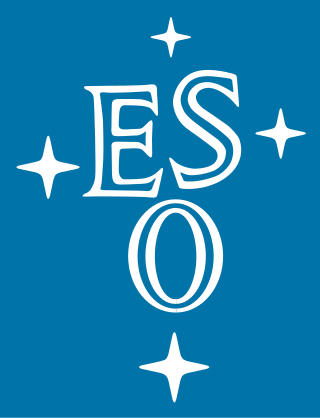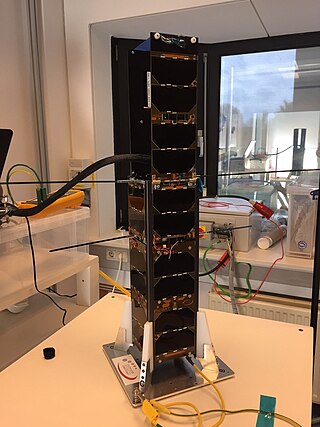
Riccardo Giacconi was an Italian-American Nobel Prize-winning astrophysicist who laid down the foundations of X-ray astronomy. He was a professor at the Johns Hopkins University.

The European Organisation for Astronomical Research in the Southern Hemisphere, commonly referred to as the European Southern Observatory (ESO), is an intergovernmental research organisation made up of 16 member states for ground-based astronomy. Created in 1962, ESO has provided astronomers with state-of-the-art research facilities and access to the southern sky. The organisation employs over 750 staff members and receives annual member state contributions of approximately €162 million. Its observatories are located in northern Chile.

The Atacama Large Millimeter/submillimeter Array (ALMA) is an astronomical interferometer of 66 radio telescopes in the Atacama Desert of northern Chile, which observe electromagnetic radiation at millimeter and submillimeter wavelengths. The array has been constructed on the 5,000 m (16,000 ft) elevation Chajnantor plateau – near the Llano de Chajnantor Observatory and the Atacama Pathfinder Experiment. This location was chosen for its high elevation and low humidity, factors which are crucial to reduce noise and decrease signal attenuation due to Earth's atmosphere. ALMA provides insight on star birth during the early Stelliferous era and detailed imaging of local star and planet formation.

Astronomy & Astrophysics (A&A) is a monthly peer-reviewed scientific journal covering theoretical, observational, and instrumental astronomy and astrophysics. It is operated by an editorial team under the supervision of a board of directors representing 27 sponsoring countries plus a representative of the European Southern Observatory. The journal is published by EDP Sciences and the current editors-in-chief are Thierry Forveille and João Alves.

Jean-Claude Pecker was a French astronomer, astrophysicist and author, member of the French Academy of Sciences and director of the Nice Observatory. He served as the secretary-general of the International Astronomical Union from 1964 to 1967. Pecker was the President of the Société astronomique de France (SAF), the French amateur astronomical society, from 1973–1976. He was awarded the Prix Jules Janssen by the French Astronomical Society in 1967. A minor planet is named after him. Pecker was a vocal opponent of astrology and pseudo-science and was the president of the Association française pour l'information scientifique (AFIS), a skeptical organisation which promotes scientific enquiry in the face of quackery and obscurantism.

Lodewijk Woltjer was an astronomer, and the son of astronomer Jan Woltjer. He studied at the University of Leiden under Jan Oort earning a PhD in astronomy in 1957 with a thesis on the Crab Nebula. This was followed by post-doctoral research appointments to various American universities and the subsequent appointment of professor of theoretical astrophysics and plasma physics in the University of Leiden. From 1964 to 1974 he was Rutherford Professor of Astronomy and Chair of the Astronomy Department at Columbia University in New York. From 1975 to 1987 he was Director General of the European Southern Observatory (ESO), where he initiated the construction of the Very Large Telescope. In 1994–1997 he was President of the International Astronomical Union. Woltjer was honored in 1987 with the Karl Schwarzschild Medal.

Astroinformatics is an interdisciplinary field of study involving the combination of astronomy, data science, machine learning, informatics, and information/communications technologies. The field is closely related to astrostatistics.

The Ordre national du Mérite is a French order of merit with membership awarded by the President of the French Republic, founded on 3 December 1963 by President Charles de Gaulle. The reason for the order's establishment was twofold: to replace the large number of ministerial orders previously awarded by the ministries; and to create an award that can be awarded at a lower level than the Legion of Honour, which is generally reserved for French citizens. It comprises about 185,000 members; 306,000 members have been admitted or promoted in 50 years.
Isabelle Ealet is a French businesswoman and investment manager who served as the global head of Goldman Sachs' securities division from 2007 to 2018. She served as an advisor on commerce to the French embassy in London.

PicSat was a French observatory nanosatellite, designed to measure the transit of Beta Pictoris b, an exoplanet which orbits the star Beta Pictoris.
Raymond Augustin Jean-Baptiste Mailhat was a French manufacturer of telescopes and precision optical instruments.
Anne-Marie Lagrange, born March 12, 1962 in the Rhône-Alpes region of France, is a French astrophysicist. Lagrange's work focuses on the research and study of extrasolar planetary systems. Lagrange is the holder of numerous scientific awards and honorary decorations, including Knight of the Legion of Honour and is a member of the French Academy of Sciences since 2013.
Science tourism is a travel topic grouping scientific attractions. It covers interests in visiting and exploring scientific landmarks, including museums, laboratories, observatories and universities. It also includes visits to see events of scientific interest, such as solar eclipses.
Nicole Capitaine is an astronomer at the Paris Observatory who is known as an expert on astrometry and related standards.
Michel Pouchard is a French chemist specialising in the physico-chemistry of inorganic solids.
Uta Fritze-von Alvensleben is a German astrophysicist awarded the German Physical Society's Hertha-Sponer prize in 2003 for her work on the evolution of galaxies.

Nathalie Palanque-Delabrouille,, is a French cosmologist. During her career as a researcher in particle physics, she has taken part in several large-scale experiments. Her work has been recognized several times including the Irène Joliot-Curie Prize, the appointment as Knight of the Legion of Honor and her election to the French Academy of Sciences.

Sylvie Vauclair is a French astrophysicist, and professor emeritus, where she taught for more than 30 years. She also taught for a decade at the Paris Diderot University. She has served as president of the Société Française d'Astronomie et d'Astrophysique.
Jean Delhaye (1921–2001) was a French astronomer and director of astronomical research at several institutes.
Fabienne Casoli is a French astronomer and academic administrator, the president of the Paris Observatory.











